What are the conditions when MySQL creates a table?
Due to the addition, deletion and modification of records in the emp table, a script is re-created here and used
create database bjpowernnode; use bjpowernode; source C:\Users\Administrator\Desktop\bjpowernode.sql;
constraints
1. What are constraints?
Constraints are the restrictions in the table
The keyword of the constraint is: constraint
2. Classification of constraints
Non-null constraint
not nullUnique Sexual constraints
uniquePrimary key constraints
primary key- ##Foreign key constraints
foreign key
- Checking constraints MySQL database does not support it, Oracle database supports it
The fields with not null constraints cannot be null values. Specific data must be created. Create a table and add non-null constraints to the fields [The user’s email address cannot be null]
drop table if exists t_user;
create table t_user(
id int(10),
name varchar(32) not null,
email varchar (32)
);

create table t_user( id int(10), name varchar(32) not null, email varchar(128) unique );
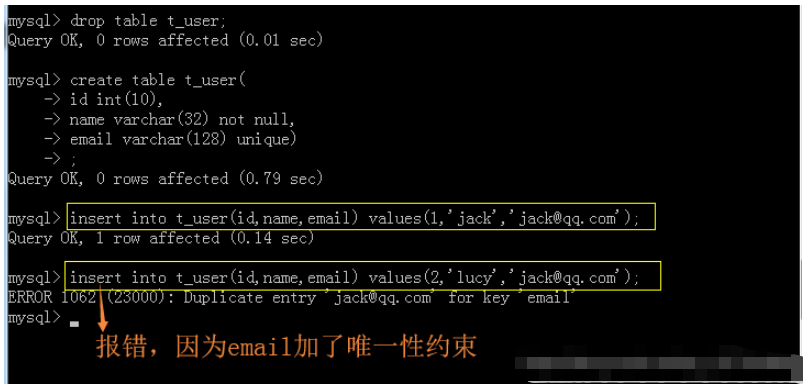
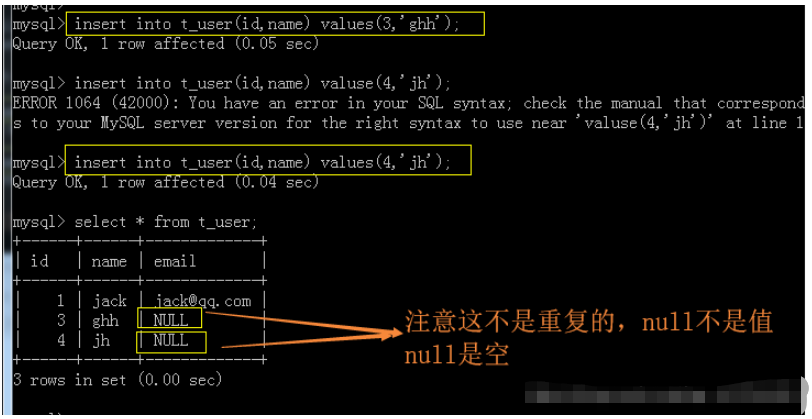
The above constraints are column-level constraints
Table-level constraints: create table t_user(
id int(10),
name varchar(32),
email varchar(128),
unique(email)
); create table t_user(
id int(10),
name varchar(32),
email varchar(128),
unique(name,email)
);
create table t_user(
id int(10),
name varchar(32),
email varchar(128),
constraint t_user_email_unique unique(email)
);

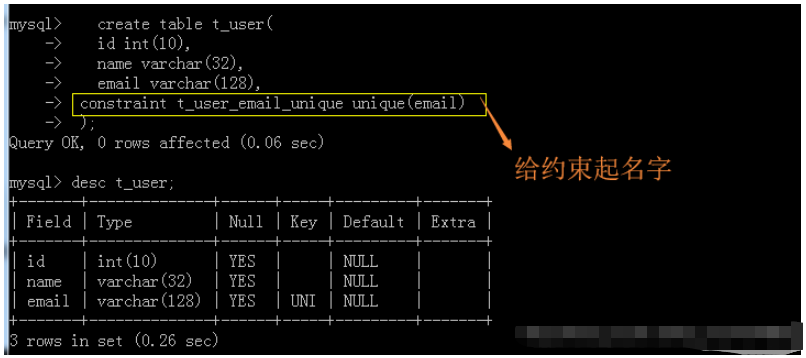 ##not null and unique can be used together
##not null and unique can be used together
 3. primary key (primary key constraint)
3. primary key (primary key constraint)
- Primary key constraint
- Primary key field
- Primary key value
- ##2. The relationship between the above three:
After adding a primary key constraint to a field in the table, the field is called the primary key field
- Each occurrence in the primary key field The data are all called primary key values
- 3. After adding a primary key constraint to a field, the field cannot be repeated or empty
The primary key constraint has the same effect as ''not null unique'', but the essence is different.
- Primary key constraint can also achieve ''not null unique'' In addition to
- the primary key field will also be added with ''index-index'' by default
- 4. A table should have Primary key field, if not, it means that this table is invalid
The primary key value is the unique identifier of the current row of data
- The primary key value is the ID number of the current row of data
- Even if the two rows of record data in the table are exactly the same,
- But because If the primary key values are different, they are considered to be two completely different fields in the two rows
- 5. Whether it is a single primary key or a composite primary key, a table can only have one primary key constraint.
Adding a primary key constraint to a field is called a single primary key constraint
- Adding a primary key constraint to multiple fields jointly is called a single primary key constraint It is called a composite primary key
- 6. Primary keys are classified according to their properties:
Natural primary key: The primary key value is a natural number , this primary key has nothing to do with the current business
- Business primary key: The primary key value is closely related to the current business
- When the business changes , the primary key value will always be affected, so the business primary key is of little use.
- Single primary key, column-level constraints
create table t_user(
id int(10) primary key,
name varchar(32)
);Single primary key, table-level constraints
create table t_user(
id int(10),
name varchar(32),
primary key(id)
);
Composite primary key: only table-level constraints can be used
mysql> create table t_user(
-> id int(10),
-> name varchar(32),
-> primary key(id,name)
-> );
auto_increment:主键自增
MySQL数据管理系统中提供了一个自增的数字,专门用来自动生成主键值
主键值不需要用户维护,也不需要用户提供了,自动生成的,
这个自增的数字默认从1开始以1递增:1,2,3,4,....
mysql> create table t_user(
-> id int(10) primary key auto_increment,
-> name varchar(32)
-> );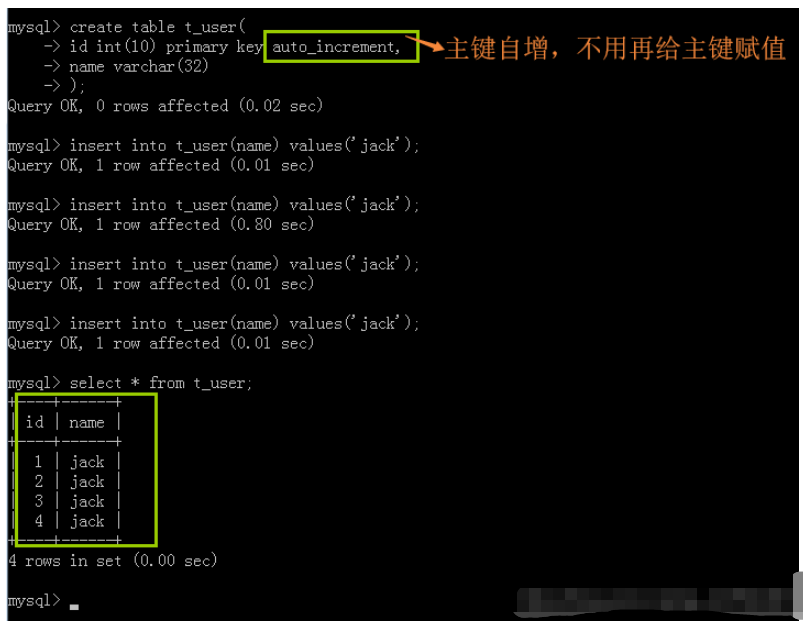
4. foreign key(外键约束)
1.外键约束涉及到的术语:
外键约束
外键值
外键字段
2.以上三者之间的关系:
某个字段添加外键约束以后称为外键字段
外键字段中的每一个数据称为外键值
3.外键分为单一外键和复合外键
单一外键:给一个字段添加外键约束
复合外键:给多个字段添加外键约束
4.一张表中可以有多个外键字段
设计一个数据库表,用来存储学生和班级信息,给出两种解决方案:
学生信息和班级信息之间的关系:一个班级对应多个学生,这是典型的一对多的关系
在多的一方加外键
第一种设计方案:将学生信息和班级信息存储到一张表中
第二种设计方案:将学生信息和班级信息分开两张表存储,学生表+班级表
学生表 t_student
| sno(主键约束) | sname | classno(外键约束) |
|---|---|---|
| 1 | jack | 100 |
| 2 | lucy | 100 |
| 3 | kk | 100 |
| 4 | smith | 200 |
| 5 | frank | 300 |
| 6 | jhh | 300 |
班级表t_calss
| cno(主键约束) | cname |
|---|---|
| 100 | 高三1班 |
| 200 | 高三2班 |
| 300 | 高三3班 |
为了保证t_student 表中的classno字段中的数据必须来自于t_class表中的cno字段中的数据,有必要给t_student表中的classno字段添加外键约束,classno称为外键字段,该字段中的值称为外键值。
注意:
1.外键值可以为空
2.外键字段必须得引用这张表中的主键吗?
外键字段引用一张表的字段的时候,被引用的字段必须具备唯一性
即具有unique约束,不一定非是主键
3.班级表为父表,学生表为子表
应该先创建父表,再创建子表
删除数据时,应该先删除子表中的数据,再删除父表中的数据
插入数据时,应该先插入父表中的数据,再删除子表中的数据
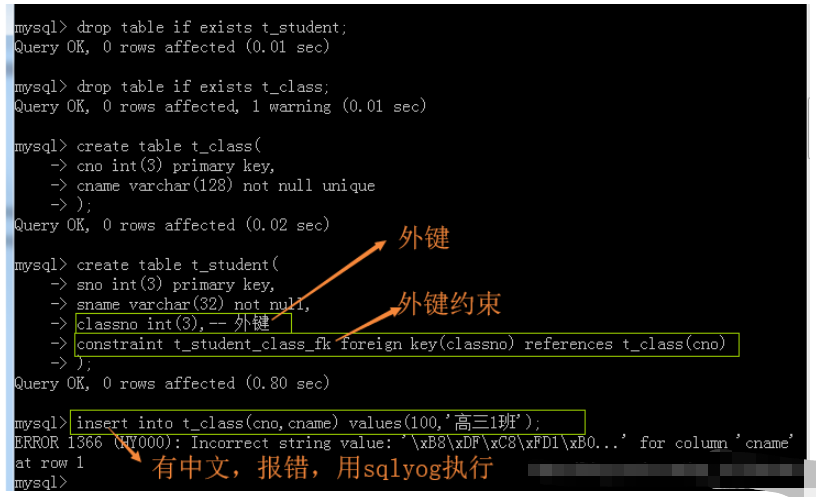
DROP TABLE IF EXISTS t_student; DROP TABLE IF EXISTS t_class; CREATE TABLE t_class( cno INT(3) PRIMARY KEY, cname VARCHAR(128) NOT NULL UNIQUE ); CREATE TABLE t_student( sno INT(3) PRIMARY KEY, sname VARCHAR(32) NOT NULL, classno INT(3),-- 外键 CONSTRAINT t_student_class_fk FOREIGN KEY(classno) REFERENCES t_class(cno) ); INSERT INTO t_class(cno,cname) VALUES(100,'高三1班'); INSERT INTO t_class(cno,cname) VALUES(200,'高三2班'); INSERT INTO t_class(cno,cname) VALUES(300,'高三3班'); INSERT INTO t_student(sno,sname,classno) VALUES(1,'jack',100); INSERT INTO t_student(sno,sname,classno) VALUES(2,'lucy',100); INSERT INTO t_student(sno,sname,classno) VALUES(3,'hh',100); INSERT INTO t_student(sno,sname,classno) VALUES(4,'frank',200); INSERT INTO t_student(sno,sname,classno) VALUES(5,'smith',300); INSERT INTO t_student(sno,sname,classno) VALUES(6,'jhh',300); SELECT * FROM t_student; SELECT * FROM t_class; -- 添加失败,因为有外键约束 INSERT INTO t_student(sno,sname,classno) VALUES(8,'kk',500);
重点:典型的一对多关系,设计时在多的一方加外键
5. 级联更新与级联删除
在删除父表中的数据的时候,级联删除子表中的数据
在更新父表中的数据的时候,级联更新子表中的数据
以上的级联更新和级联删除谨慎使用,
因为级联操作会使数据数据改变或删除,数据是无价的。
语法:
级联更新:
on update cascase级联删除:
on delete cascase


MySQL中对于有些约束的修改比较麻烦,所以应该先删除约束,再添加约束
删除外键约束:
alter table t_student drop foreign key t_student_class_fk
添加外键约束并级联更新:
alter table t_student add constraint t_student_class_fk foreign key(classno) references t_class(no) on delete cascade;
添加外键约束并级联删除:
alter table t_student add constraint t_student_class_fk foreign key(classno) references t_class(no) on update cascade;
级联删除


级联更新


The above is the detailed content of What are the conditions when MySQL creates a table?. For more information, please follow other related articles on the PHP Chinese website!

Hot AI Tools

Undresser.AI Undress
AI-powered app for creating realistic nude photos

AI Clothes Remover
Online AI tool for removing clothes from photos.

Undress AI Tool
Undress images for free

Clothoff.io
AI clothes remover

Video Face Swap
Swap faces in any video effortlessly with our completely free AI face swap tool!

Hot Article

Hot Tools

Notepad++7.3.1
Easy-to-use and free code editor

SublimeText3 Chinese version
Chinese version, very easy to use

Zend Studio 13.0.1
Powerful PHP integrated development environment

Dreamweaver CS6
Visual web development tools

SublimeText3 Mac version
God-level code editing software (SublimeText3)

Hot Topics
 1386
1386
 52
52
 MySQL: Simple Concepts for Easy Learning
Apr 10, 2025 am 09:29 AM
MySQL: Simple Concepts for Easy Learning
Apr 10, 2025 am 09:29 AM
MySQL is an open source relational database management system. 1) Create database and tables: Use the CREATEDATABASE and CREATETABLE commands. 2) Basic operations: INSERT, UPDATE, DELETE and SELECT. 3) Advanced operations: JOIN, subquery and transaction processing. 4) Debugging skills: Check syntax, data type and permissions. 5) Optimization suggestions: Use indexes, avoid SELECT* and use transactions.
 How to open phpmyadmin
Apr 10, 2025 pm 10:51 PM
How to open phpmyadmin
Apr 10, 2025 pm 10:51 PM
You can open phpMyAdmin through the following steps: 1. Log in to the website control panel; 2. Find and click the phpMyAdmin icon; 3. Enter MySQL credentials; 4. Click "Login".
 MySQL: An Introduction to the World's Most Popular Database
Apr 12, 2025 am 12:18 AM
MySQL: An Introduction to the World's Most Popular Database
Apr 12, 2025 am 12:18 AM
MySQL is an open source relational database management system, mainly used to store and retrieve data quickly and reliably. Its working principle includes client requests, query resolution, execution of queries and return results. Examples of usage include creating tables, inserting and querying data, and advanced features such as JOIN operations. Common errors involve SQL syntax, data types, and permissions, and optimization suggestions include the use of indexes, optimized queries, and partitioning of tables.
 Why Use MySQL? Benefits and Advantages
Apr 12, 2025 am 12:17 AM
Why Use MySQL? Benefits and Advantages
Apr 12, 2025 am 12:17 AM
MySQL is chosen for its performance, reliability, ease of use, and community support. 1.MySQL provides efficient data storage and retrieval functions, supporting multiple data types and advanced query operations. 2. Adopt client-server architecture and multiple storage engines to support transaction and query optimization. 3. Easy to use, supports a variety of operating systems and programming languages. 4. Have strong community support and provide rich resources and solutions.
 How to use single threaded redis
Apr 10, 2025 pm 07:12 PM
How to use single threaded redis
Apr 10, 2025 pm 07:12 PM
Redis uses a single threaded architecture to provide high performance, simplicity, and consistency. It utilizes I/O multiplexing, event loops, non-blocking I/O, and shared memory to improve concurrency, but with limitations of concurrency limitations, single point of failure, and unsuitable for write-intensive workloads.
 MySQL and SQL: Essential Skills for Developers
Apr 10, 2025 am 09:30 AM
MySQL and SQL: Essential Skills for Developers
Apr 10, 2025 am 09:30 AM
MySQL and SQL are essential skills for developers. 1.MySQL is an open source relational database management system, and SQL is the standard language used to manage and operate databases. 2.MySQL supports multiple storage engines through efficient data storage and retrieval functions, and SQL completes complex data operations through simple statements. 3. Examples of usage include basic queries and advanced queries, such as filtering and sorting by condition. 4. Common errors include syntax errors and performance issues, which can be optimized by checking SQL statements and using EXPLAIN commands. 5. Performance optimization techniques include using indexes, avoiding full table scanning, optimizing JOIN operations and improving code readability.
 MySQL's Place: Databases and Programming
Apr 13, 2025 am 12:18 AM
MySQL's Place: Databases and Programming
Apr 13, 2025 am 12:18 AM
MySQL's position in databases and programming is very important. It is an open source relational database management system that is widely used in various application scenarios. 1) MySQL provides efficient data storage, organization and retrieval functions, supporting Web, mobile and enterprise-level systems. 2) It uses a client-server architecture, supports multiple storage engines and index optimization. 3) Basic usages include creating tables and inserting data, and advanced usages involve multi-table JOINs and complex queries. 4) Frequently asked questions such as SQL syntax errors and performance issues can be debugged through the EXPLAIN command and slow query log. 5) Performance optimization methods include rational use of indexes, optimized query and use of caches. Best practices include using transactions and PreparedStatemen
 Monitor Redis Droplet with Redis Exporter Service
Apr 10, 2025 pm 01:36 PM
Monitor Redis Droplet with Redis Exporter Service
Apr 10, 2025 pm 01:36 PM
Effective monitoring of Redis databases is critical to maintaining optimal performance, identifying potential bottlenecks, and ensuring overall system reliability. Redis Exporter Service is a powerful utility designed to monitor Redis databases using Prometheus. This tutorial will guide you through the complete setup and configuration of Redis Exporter Service, ensuring you seamlessly build monitoring solutions. By studying this tutorial, you will achieve fully operational monitoring settings




